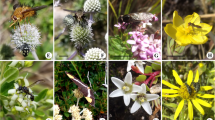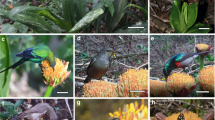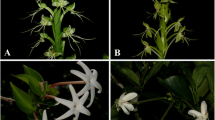Abstract
This study investigates the pollination ecology and related floral traits of the species Daucus carota subsp. commutatus in the isolated archipelago of Columbretes, E. Spain, where bees are absent. Two populations were studied: a small population found on a relatively large island (Grossa) inhabited nowadays by three people; and a larger population on a smaller uninhabited island (Foradada). The plant, found also in other rocky coastal enclaves of the west Mediterranean, is totally self-compatible, andromonoecious, exhibiting strong protandrous dichogamy and sequential flowering of umbel orders, with limited probability of self pollination at the plant level. Pollination on both study islands is carried out solely by flies, mainly by Eristalis tenax (Syrphidae), a long distance visitor and efficient pollinator, but irregular migrant to the archipelago; and Lucilia sericata (Calliphoridae), an abundant flower visitor but less efficient pollinator dependent on human and avian wastes for its larval growth. The small population on Grossa appears not to suffer pollen limitation. Seed set is reduced, however, in the large population on Foradada, which we attribute to the low pollinator capital of this island, which is too small to attract and sustain migrant hoverflies and where no human and avian wastes are available to sustain blowfly growth. We conclude that in isolated environments with reduced or unpredictable pollinator capital, long distance migrant pollinators, such as E. tenax, play an invaluable conservation and perhaps evolutionary role for the native plants. Because these islands have been always practically uninhabited we argue that the absence of adequate local pollinator capital is perhaps compensated by the selection of particular floral traits, which differentiate the study subspecies from other conspecifics. Such traits are: the exposure of nectar during male versus female stage to enhance quick pollen flow; the extended stigma receptivity period (up to 10 days) resulting in a total flower life span of up to 22 days, enabling an adequate pollen deposition on stigmas even under low pollen transfer rates. In this respect, the low flower sex ratio (hermaphrodite: staminate) compared to other conspecifics studied elsewhere may be also relevant.











Similar content being viewed by others
References
Anderson GJ, Bernardello G, Stuessy TF, Crawford DJ (2001) Breeding system and pollination of selected plants endemic to Juan Fernández islands. Am J Bot 88:220–233
Barrett SCH (1996) The reproductive biology and genetics of island plants. Phil Trans R Soc B 351:725–733
Beattie AJ (1972) A technique for the study of insect-borne pollen. Pan-Pacific Entomol 47:82
Bell CR (1971) Breeding systems and floral biology of the Umbelliferae or evidence for specialization in unspecialized flowers. In: Heywood VH (ed) The biology and chemistry of the umbelliferae. Academic Press, New York, pp 93–107
Bell CR, Lindsey AH (1978) The umbel as a reproductive unit in the Apiaceae. In: Cauwet-Marc AM, Carbonnier J (eds) Les ombellifères: contributions pluridisciplinaires à la systématique. Perpignan, France, pp 739–747
Bell G, Lefebvre L, Giraldeau LA, Weary D (1984) Partial preference of insects for the male flowers of an annual herb. Oecologia 64:287–294
Berry E, Calvo RN (1989) Wind pollination, self incompatibility and altitudinal shifts in pollination systems in the high Andean genus Espeletia (Asteraceae). Am J Bot 76:1602–1614
Blondel J, Aronson J (1999) Biology and wildlife of the Mediterranean region. Oxford University Press, New York
Bohart GE, Nye WP (1960) Insect pollinators of carrots in Utah. Utah Agric Exp Stn Bull 419:1–15
Borthwick HA, Emsweller SI (1933) Carrot breeding experiments. Proc Amer Soc Hort Sci 30:531–533
Braak JP, Kho YO (1958) Some observations on the floral biology of the carrot (Daucus carrota L.). Euphytica 7:131–139
Carlquist S (1974) Island biology. Columbia University Press, New York
Culley TM, Weller SG, Sakai AK (2002) The evolution of wind pollination in angiosperms. Trends Ecol Evol 17:361–369
Dafni A (1992) Pollination ecology. A practical Approach. Oxford, Oxford University Press
Eisikowitch D (1980) The role of dark flowers in the pollination of certain Umbelliferae. J Nat Hist 14:737–742
Español F (1958) Contribución al conocimiento de los artrópodos y moluscos terrestres de las Islas Columbretes. Misc Zool 1:3–37
Fausto Jr JA, Eckhart VM, Geber MA (2001) Reproductive assurance and the evolutionary ecology of self-pollination in Clarkia xanthiana (Onagraceae). Am J Bot 88:1794–1800
Fischer M, Matthies D (1998) RAPD variation in relation to population size and plant fitness in the rare Gentianella germanica (Gentianaceae). Am J Bot 86:811–819
Free JB (1993) Insect Pollination of Crops. Academic Press, London
Fryxell PA (1957) The mode of reproduction in higher plants. Bot Rev 23:135–233
García Marí F, Ferradgut F, Navarro V, Laborda R, Costa-Comelles J (1991) Nuevas aportaciones al conocimiento de los artrópodos de las Islas Columbretes. In: Alonso LA, Carretero JL, García-Carrascosa MA (eds) Islas Columbretes: Contribución al estudio de su medio natural. Colección Monografías no 5, Consellería de Obras Públicas, Urbanismo y Transportes—Agencia del Medi Ambient—Generalitat Valenciana, Valencia, pp 155–179
Gómez JM, Zamora R (1996) Wind pollination in high mountain populations of Hormathophylla spinosa (Cruciferae). Am J Bot 83:580–585
Goodwillie C (1999) Wind pollination and reproductive assurance in Linanthus parviflorus (Polemoniaceae), a self-incompatible annual. Am J Bot 86:948–954
Groom MJ (1998) Allee effects limit population viability of an annual plant. Am Nat 151:487–496
Groom MJ (2001) Consequences of subpopulation isolation for pollination, herbivory, and population growth in Clarkia concinna. Biol Conserv 100:55–63
Hawthorn LR, Bohart GE, Toole EH (1956) Carrot seed yield and germination as affected by different levels of insect pollination. Proc Amer Soc Hort Sci 67:384–389
Howarth FG, Mull WP (1992) Hawaiian insects and their kin. University of Hawaii Press, Honolulu
Hussein MH, Abden-Aal SA (1982) Wild and honey bees as pollinators of 10 plant species in Assiut area. Egypt Z Angew Ent 93:342–346
Juan A (2002) Studies on morphology, genetic variability and reproductive biology of Medicago citrina (Font Quer) Greuter (Leguminosae)—Bases for its conservation. Unpublished PhD Thesis, University of Alicante
Kearns CA, Inouye DW (1993) Techniques for pollination biologists. University Press of Colorado, Niwot, Colorado
Knuth P (1908) Handbook of Flower Pollination, Vol II The Clarendon Press, Oxford
Koul AK, Koul P, Hamal IA (1986) Insects in relation to pollination of some umbellifers. Bull Bot Surv India 28:39–42
Koul P, Koul AK, Hamal IA (1989) Reproductive biology of wild and cultivated carrot (Daucus carota L.). New Phytol 112:437–443
Lamborn E, Ollerton J (2000) Experimental assessment of the functional morphology of inflorescences of Daucus carota (Apiaceae): testing the ‘fly catcher effect’. Funct Ecol 14:445–454
Lázaro T, Traveset A (2005) Spatio-temporal variation in the pollination mode of Buxus balearica (Buxaceae), an ambophilous and selfing species: mainland-island comparison. Ecography 28:640–652
Lovett-Doust J (1980) Floral sex ratios in andromonoecious Umbelliferae. New Phytol 85:265–273
McCullen CK (1990) Reproductive biology in Galapagos Islands angiosperms. Monogr Syst Bot 32:35–45
Menges ES, Dolan RW (1998) Demographic viability of populations of Silene regia in midwestern prairies: relationships with fire management, genetic variation, geographic location, population size and isolation. J Ecol 86:63–78
Oostermeijer JGB, Luijten SH, Petanidou T, Kos M, Ellis-Adam AC, den Nijs JCM (2000) Pollination in rare plants: is population size important? The Scandinavian Association for Pollination Ecology honours Knut Faegri. I Matematisk Naturvidenskapelige Klasse, Skifter. Det Norske Videnskaps-Akademi 39:201–213
Oostermeijer JGB, van Eijck MW, den Nijs JCM (1994) Offspring fitness in relation to population size and genetic variation in the rare perennial plant species Gentiana pneumonanthe. Oecologia 97:289–296
Ouborg NJ (1993) Isolation, population size and extinction: the classical and metapopulation approaches applied to vascular plants along the Dutch Rhine-system. Oikos 66:298–308
Ouborg NJ, Van Treuren R, van Damme JMM (1991) The significance of genetic erosion in the process of extinction. II Morphological variation and fitness components of varying size of Salvia pratensis L. and Scabiosa columbaria L. Oecologia 86:359–367
Pérez-Bañón C (2000) Biology of the syrphids (Diptera: Syrphidae) of the insular ecosystems in the Community of Valencia: aspects of the insect-plant relationship. Unpublished PhD Thesis. University of Alicante
Pérez-Bañón C, Juan A, Petanidou T, Marcos-García MA, Crespo MB (2003) The reproductive ecology of Medicago citrina (Font Quer) Greuter (Leguminosae), a bee-dependent plant in bee-deprived Mediterranean islands. Pl Syst Evol 241:29–46
Petanidou T (2004) Temporal patterns of resource selection in plant-pollinator communities in the Mediterranean: what can they really tell us? In: Arianoutsou M, Papanastasis V (eds) Ecology, Conservation and Management of Mediterranean Climate Ecosystems—Proceedings 10th MEDECOS Conference, Rhodos, CD ISBN 90 5966 016 1. Millpress, Rotterdam
Petanidou T, Ellis WN (1996) Interdependence of native bee faunas and floras in changing Mediterranean communities. In: Matheson A, Buchmann SL, O’Toole C, Westrich P, Williams IH (eds) The conservation biology of bees. Linnean society symposium series No 18, Academic Press, London, pp 201–226
Petanidou T, Ellis WN, Margaris NS, Vokou D (1995) Constraints on flowering phenology in a phryganic (East Mediterranean) ecosystem. Am J Bot 82:607–620
Petanidou T, Lamborn E (2005) A land for flowers and bees: studying pollination ecology in Mediterranean communities. Plant Biosyst 139:279–294
Petanidou T, Smets E (1995) The potential of marginal lands for apiculture: nectar secretion in Mediterranean shrublands. Apidologie 26:39–52
Pujadas-Salvà AJ (2003) Daucus L. In: Flora Ibérica, vol X: Araliaceae-Umbelliferae. Real Jardín Botánico, CSIC, Madrid, pp 97–125
Proctor M, Yeo P, Lack A (1996) The natural history of pollination. Harper Collins Publishers, London
Ramsey M, Vaughton G (1996) Inbreeding depression and pollinator availability in a partially self-fertile perennial herb Blandfordia grandiflora (Liliaceae). Oikos 76:465–474
Ricciardelli d’Albore G-C (1986) Les insectes pollinisateurs de quelques Ombellifères d’intérêt agricole et condimentaire (Angelica archangelica L., Carum carvi L., Petroselinum crispum A.W. Hill., Apium graveolens L., Pimpinella anisum L., Daucus carota L., Foeniculum vulgare Miller v. azoricum Thell.). Apidologie 17:107–124
Serrano-Adell R (1991) Historia de los asentamientos humanos en las Coumbretes. In: Alonso LA, Carretero JL, García-Carrascosa MA (eds) Islas Columbretes: Contribución al estudio de su medio natural. Colección Monografías no 5, Consellería de Obras Públicas, Urbanismo y Transportes - Agencia del Medi Ambient - Generalitat Valenciana, Valencia, pp 13–18
Sokal RR, Rohlf FJ (1995) Biometry: the principles and practice of statistics in biological research, 3rd edn. WH Freeman, New York
Thomson JD (2005) Plant evolution in the Mediterranean. Oxford University Press, Oxford etc
Van Treuren R, Bijlsma R, Ouborg NJ, Van Delden W (1991) The significance of genetic erosion in the process of extinction. I Genetic differentiation in Salvia pratensis and Scabiosa columbaria in relation to population size. Heredity 66:181–189
Westmoreland D, Muntan C (1996) The influence of dark central florets on insect attraction and fruit production in Queen Anne’s Lace (Daucus carota L.). Am Midl Nat 135:122–129
Young AG, Brown AHD, Zich FA (1999) Genetic structure of fragmented populations of the endangered Daisy Rutidosis leptorrhynchoides. Conserv Biol 13:256–265
Acknowledgements
The project has been financially supported by the investigation projects GV-C-RN-12-069-96 and BSO2000-0148. We thank Conselleria de Medio Ambiente de Generalitat Valenciana for allowing us to carry out this study in the Columbretes Natural Park. Special thanks to Juan Jiménez and José Vicente Escobar for logistics and all the guards of the Park for their help and language coursing during the fieldwork. We thank Willem N Ellis for permitting and advising us how to use his ad hoc written G-test statistical program. The paper has benefited from the criticism by Ellen Lamborn, who read a previous version of the manuscript.
Author information
Authors and Affiliations
Corresponding author
Rights and permissions
About this article
Cite this article
Pérez-Bañón, C., Petanidou, T. & Marcos-García, M. Pollination in small islands by occasional visitors: the case of Daucus carota subsp. commutatus (Apiaceae) in the Columbretes archipelago, Spain. Plant Ecol 192, 133–151 (2007). https://doi.org/10.1007/s11258-006-9233-1
Received:
Accepted:
Published:
Issue Date:
DOI: https://doi.org/10.1007/s11258-006-9233-1




